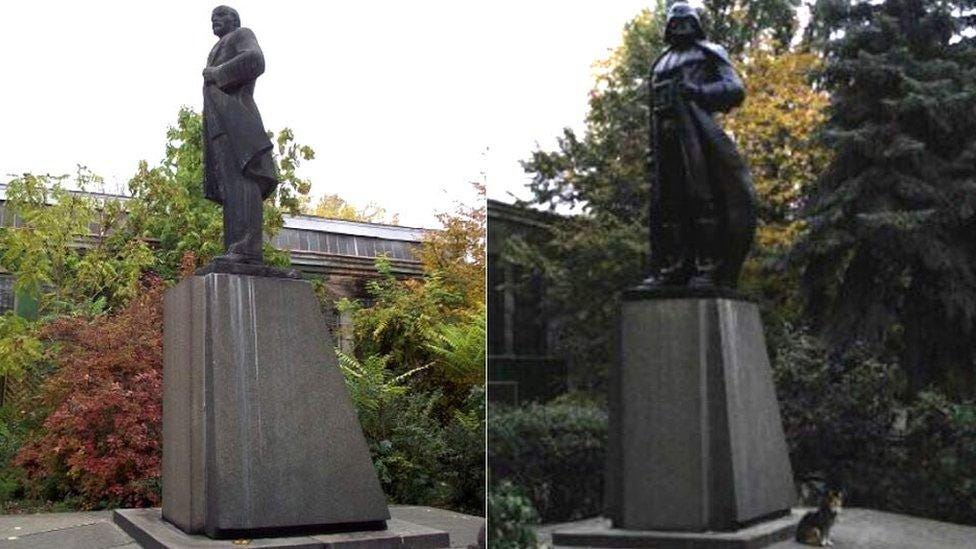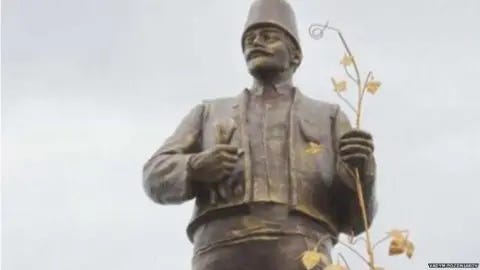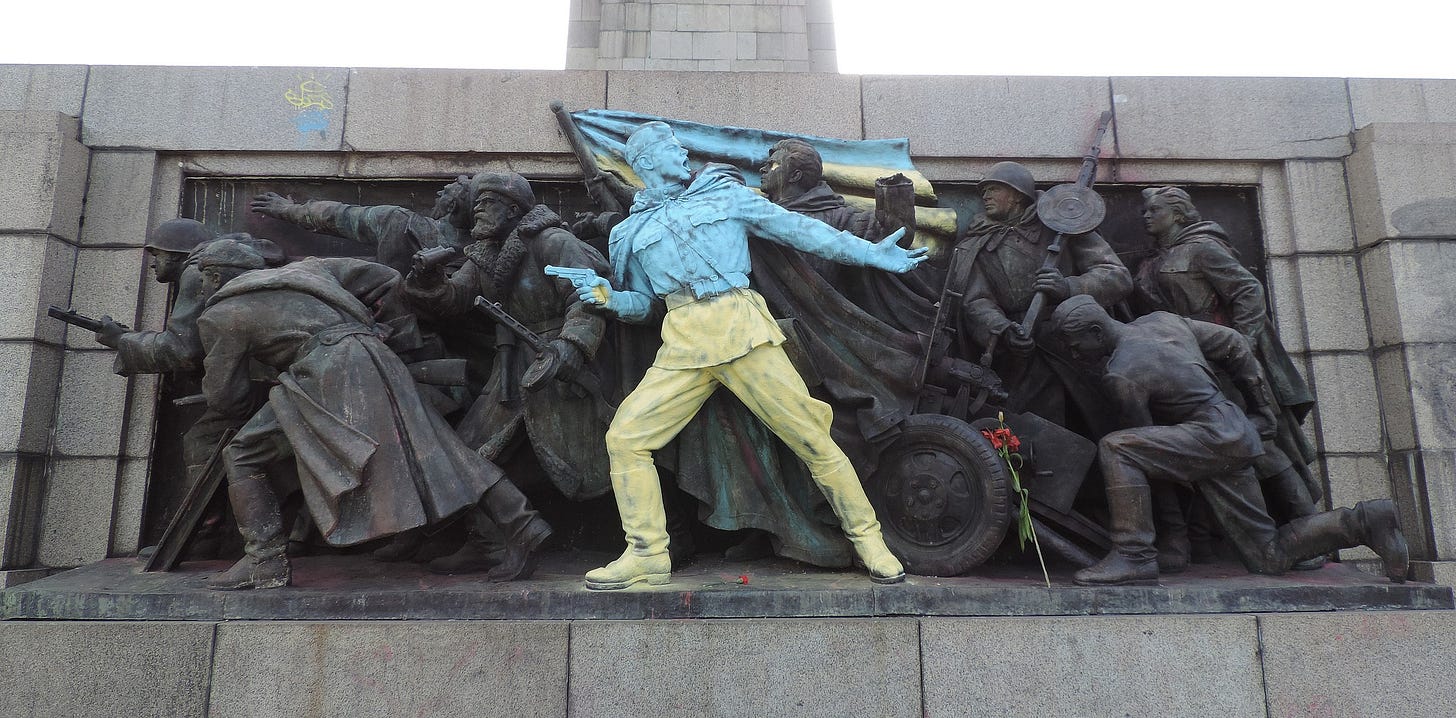#5: Lenin, Darth Vader, and the difficulty of memory laws
How Ukrainian artists once imaginatively remembered their country's history — and why they must again

In April 2015, Ukraine’s parliament passed four bills outlawing communist and Nazi symbols, a move widely seen as a response to Russia’s annexation of Crimea in early 2014. Days after the legislation was passed, municipal authorities across Ukraine began removing monuments and symbols linked to the Soviet Union and Nazi Germany. By one estimate, about 2400 such monuments were removed between 2015 and 2020 in Ukraine. Efforts to de-communise and de-nazify intensified further following Russia’s invasion of Ukraine in 2022, as entire regions declared a successful purge of all communist symbols.
Some monuments, however, were not removed but instead re-purposed to align with the political climate. One striking example is a statue of Vladimir Lenin in an Odessa park, which Ukrainian sculptor Alexander Milov transformed into Darth Vader, the iconic Star Wars villain. In addition to its new appearance, the statue received a technological upgrade—its helmet now emits free Wi-Fi, turning a solemn relic of the past into an unexpected hub for public interaction.
Milov’s Vader isn’t the only curiously transformed sculpture in Ukraine. In 2020 another monument to Lenin in Zaliznychne, a village in the Odessa region, was recast in ethnic Bulgarian attire to pay tribute to the Bulgarian settlers who founded the village. Commenting on the statue’s makeover, some Ukrainians characterised these transformations as instances of ‘positive decommunisation’, an alternative mode of preserving the painful legacy of communist rule in Ukraine.

Appearing at a time Ukrainian society was intensely divided on how – or even whether – to commemorate the legacy of communist rule in the country, these examples of ‘positive decommunization’ seemingly offered a non-partisan mode of remembering its history. It is unclear whether both sculptures have survived Russia’s ongoing invasion of Ukraine, which has now entered its third year and resulted in more than a million casualties. But this mode of public remembrance, I believe, remains critical even as the Ukrainian state continues its struggle for survival.
…
‘Memory’ laws – legal provisions which regulate how certain historical events are remembered – are not unique to Ukraine. Throughout history, several countries have enacted such laws to secure political legitimacy, promote a specific idea of citizenship, or to suppress acknowledgement of and complicity in past atrocities. Often, such laws have resulted in censorship of competing narratives that are considered damaging to the national interest. There are many prominent examples, including Israel’s ‘Nakba Law’ which censors discourse on the mass displacement of Palestinians in 1948 and Spain’s Democratic Memory Law which penalises the use of Francoist symbols.
In Ukraine and the former Eastern Bloc, the struggle over historical memory specifically seeks to counter Russian irredentism. This is done by rejecting Soviet-era symbols and narratives in favour of ‘national’ histories that emphasise the scale of atrocities committed by Soviet Russia during the second World War. While Ukraine, Poland, and other former Eastern Bloc nations commemorate events such as the Soviet repression of Polish citizens and the Holodomor, extensive accounts of these atrocities remain absent from popular histories of World War II in Western Europe, where narratives focus primarily on the war crimes committed by Nazi Germany.
According to political scientist Maria Mälksoo, the present-day memory politics of Central and Eastern European states is focused on enlarging the ‘mnemonic vision’ of Europe by reasserting their own ‘subaltern past’. In her assessment, Central and Eastern European nations feel pressured to ‘save’ their historical narratives as inheritors of a violent past that has shaped their national identity—one largely overlooked in dominant European histories. This, in turn, fosters a sense of ‘status anxiety’ in both regional and international politics, driving efforts to safeguard their heritage through memory laws.

For these countries, therefore, memory laws are not merely about denying particular interpretations of the past; rather, they serve as tools to reshape regional historical narratives, making them more reflective of their own experiences within the broader European framework. Through this process, they resist as well as seek acceptance into the dominant Western European narrative of the continent’s political history.
…
But can such measures truly conjure a truthful reckoning with the past if they also attempt to overtly shape how the past should be understood?
When the laws were first introduced, polls indicated deep public division over their implementation. According to one widely cited 2016 poll, 48% of Ukrainians supported a total ban on Communist ideology, 36% opposed it, while 16% remaining undecided. Ukrainians were more sharply divided on statues of Lenin; 41% of respondents supported their demolitions, 48% opposed them, and 11% were undecided. The laws also drew intense criticism from academics, international organisations, and within Ukrainian civil society for threatening freedom of expression and media freedoms. Given Ukraine’s contentious history, researchers expressed concerns that the laws would only further divide the country.
Those concerns, it would later turn out, were well-founded. Amongst some Baltic states, memory laws have evolved from safeguards for public memory into instruments of historical revisionism that project distorted narratives of the past. In Estonia, for instance, a 2012 memory law suppressed the national movement’s history of Nazi collaboration instead of confronting its complex legacy. Poland’s Amendment to the Act on the Institute of National Remembrance of 2018, later struck down as unconstitutional, criminalised claims of Polish complicity in the Holocaust for fear of undermining Polish narratives of victimhood during World War II.
In each of these contexts, while the laws were put in place with the intent of denying legitimacy to those responsible for large scale horrors in the past, they contribute to a mode of remembering that does not do justice to the complex present-day legacy of individuals or institutions, and are fundamentally unjust to the memory of the nation as a whole.
…
Writing in 2009, Mälksoo concluded that creating a critical history of the politics of ‘common European memory’ of World War II is neither feasible nor advisable at present, as it could deepen existing divisions. Instead, she argued that European institutions must acknowledge these competing historical narratives to better understand the war’s varied impact on different populations. However, according to her, this would only be possible if Europe’s ‘mnemonic entrepreneurs’ pursue collective reconciliation with the past rather than projecting it onto the present.
In 2025, nearly three years since the full-scale Russian invasion of Ukraine began, such a collective reconciliation remains a distant possibility. The most recently available polls from 2022 indicate that nearly 76% Ukrainians now support the re-naming of streets and public spaces whose names are related to Russia. Ukrainian nationalism is at its strongest, and even if the war’s end appears closer with the election of the 46th U.S. president, as some have suggested, it will take years for Ukrainian society to reconcile with its Russian past in a non-partisan way. Given the scale and impact of the war, it is hard to imagine any Ukrainian government in the near future investing to preserve artefacts of Communist presence in the country.
At this moment, Ukraine could significantly benefit from artists like Milov who practice ‘positive decommunization’ as a form of public remembrance. When asked about the exact process of converting Lenin into Darth Vader, Milov poignantly replied “The bronze Lenin was left inside, so that the grateful or not-so-grateful descendants could exhume him, if needed”. His approach—making reversible cosmetic changes—reflects an awareness of how quickly political norms evolve. By adapting monuments to fit the present while preserving their core, this method allows for future reinterpretation, ensuring that history remains open to reassessment rather than being erased outright.
